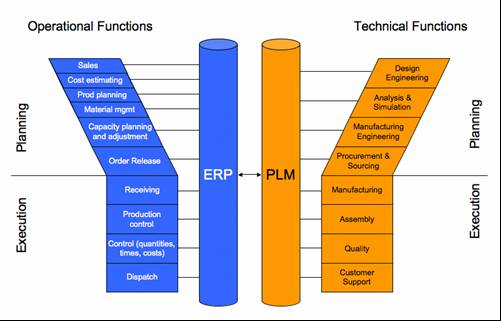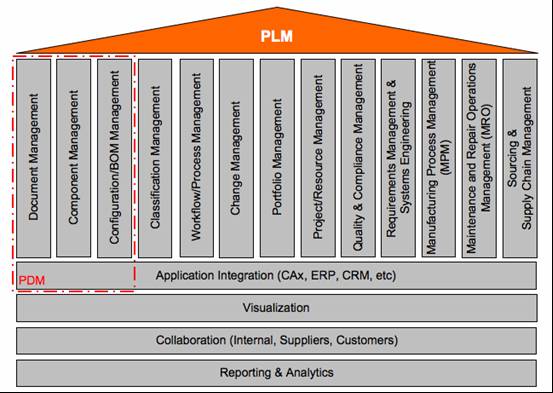Managing the life of your product
We all know that Manufacturing is all about products and that you have to keep reinventing your product portfolio to keep ahead in today’s market. Perhaps what it is not so well known is that the majority of R&D products don’t even make the market and of those that do only 1 or 2 really make a worthwhile profit. Therefore product development is a risky business, but one we can’t avoid. So how can we limit the risks and get better control of the process of controlling the life of our products?
Andy Michuda, Chief Executive Officer of Sopheon told me, “Product life cycle management (PLM) is the most vital business process in manufacturing today. A right decision on which product ideas to develop and produce can transform a company’s future. A wrong decision can bring a company to its knees. In the race for growth and profitability, the capacity to understand and act on PLM’s power will separate the winners from the losers”. But what exactly is PLM? There seem to be no standard definitions of PLM—everyone has something slightly different to say. Even the site http://www.product-lifecycle-management.info has a number of different definitions!
Let me give you my condensed definition of PLM. “It is the business process of managing the entire lifecycle of a product from its conception, through design and manufacture, to service and disposal. It integrates people, data, processes and business systems and provides a product information backbone for companies as well as their partners, suppliers and customers.” PLM is first and foremost a business discipline, whose goal is to eliminate waste and improve efficiency, and is considered to be an integral part of the lean production model. However, because of the business complexity and rate of change that requires organizations execute as rapidly as possible, application software is becoming more and more crucial to the success of PLM. It is one of the four cornerstones of a corporation’s information technology structure. Shoenhair of Ping, a PTC Customer, supports this view: “PLM can be difficult to measure, but it is absolutely critical to leaning out processes, and critical to improving information flow and control.”
Where do ERP and PLM fit? Most manufacturing companies distinguish two main process chains: the operational process chain and the technical process chain. ERP systems largely address the operational process chain, whereas PLM systems automate and enable predominantly the technical process chain.

Figure 1: ERP and PLM (Source: PLM Technology Guide)
Johan Malmström, PLM Business Development Manager, SAP, emphasised the collaborative nature of PLM, “PLM makes sure that everyone works towards one version of the truth, with clearly defined tasks and responsibilities. It manages the product structure and related information, the usage of this data across the product lifecycle as well as the process of creating this data. Process support includes workflow capabilities, program and project management, resource management etc. to make sure that the correct resources are working on the correct tasks in order to deliver the right products to the market in the right time.”
Michuda explained that PLM is implemented in practice on three different levels, each of which is supported by a different tool set.
- Transactional Processes: Enterprise resource planning (ERP) applications manage transactional processes. They are designed to unify materials planning, purchasing, financial transactions, accounting and reporting into streamlined transactional processes. Supply chain management (SCM) and customer relationship management (CRM) applications also address process needs at this level.
- Technical Data: Computer-aided design (CAD) applications, as well as those related to formula, recipe, or product data management (PDM), are primarily focused on managing the masterfile of descriptive data within the product lifecycle. These PLM systems streamline and continuously improve the processes of defining, designing and producing products, while potentially also supporting aspects of product innovation. They offer collaboration capabilities that enable enterprise-wide sharing of product designs, reducing the chance of design and manufacturing errors.
- Business Information: The business level of PLM deals with business issues around critical business-related decisions within the product lifecycle. At the business level of PLM, the emphasis is on solutions that handle innovation governance issues such as process management, decision support, idea management, product portfolio management, expertise management, and intelligence around markets, competitors and technologies. Regulatory compliance and sustainability that important not only during product innovation but also to effective management of the supply chain are also included within the business level.
So what tools are used in a PLM solution? The PLM Technology Guide shows the core technology of a PLM system and some of the many solutions that can rest on the basic technology. The orange line outlines Product Data Management (PDM), which is typically used for basic CAD file and Data Management.

Figure 2 PLM Functionality Source: PLM Technology Guide
Who are the main players? The major players in PLM space can be grouped under 3 broad categories:
- PLM product vendors such as Dassault Systemes , PTC ,Siemens, Sopheon, Aras
- The ERP vendors such as Oracle Agile, SAP PLM, Infor PLM, Epicor, IFS
- Consulting & implementation companies such as Accenture, Atos Origin, Capgemini, ITC Infotech, IBM, Infosys, KSA, Wipro and HCL Technologies.
What is coming? Dassault Systemes, on their web site, describe PLM v2 – “PLM 2.0 is a major redefinition of the PLM markets targeting all users creating, consuming and remixing IP. PLM 2.0 is to PLM what Web 2.0 is to the Web, harnessing collective intelligence from online communities. Any user can imagine, share and experience products in the universal language of 3D. PLM 2.0 brings knowledge, from idea to product experience (IP), to life. It merges the real and virtual in an immersive lifelike experience.” SAP’s Malmström sees the following three trends:
- Consumer-Driven Sustainable Innovation: with a focus on developing the right products at the right time in fast innovation cycles.
- Global Price and Time Pressure: requires development efficiency, sharing of information in dynamic development networks.
- Increasing Product Compliance and Regulations: manage compliance, controls, documentation and visibility.
Mike Spragg, Infor’s UK director for the process industries, sees the increase in environmental awareness and the incorporation of the ‘green’ agenda as an area of PLM expansion, “PLM has much to offer manufacturers. PLM begins at the earliest possible stages of design, meaning these new green considerations are factored in long before products are manufactured and then enter the supply chain. This can save costs that would have to be borne were the products reworked at a later date.”
Deepankar Ghosh, Head – Manufacturing Practice, ITC Infotech, provided a clear idea of the importance of PLM, “PLM industry is comparatively a niche industry which is gaining more currency and acceptance as organizations are realizing the value that the PLM process brings to the table. With an ever increasing pressure on bottom line it is imperative that companies make IT investments where the ROI is not only high but faster. A more informed and demanding customer is seeking not only cheaper but innovative and trendy products more than ever before. For an organization to be ahead of its competition, collaboration across key roles and functions within the company and with its supply chain has become critical. The environment for the PLM practice to grow is just right and we will soon be witnessing an unprecedented interest in this area.”
So, if ERP manages your operations, PLM manages your product portfolio from creation to end of life. My experience of PLM solutions is that they really do provide value—you just need to find the one that best suits your pocket and needs. If that is the case then come along to PLM Connect and find the answer.
